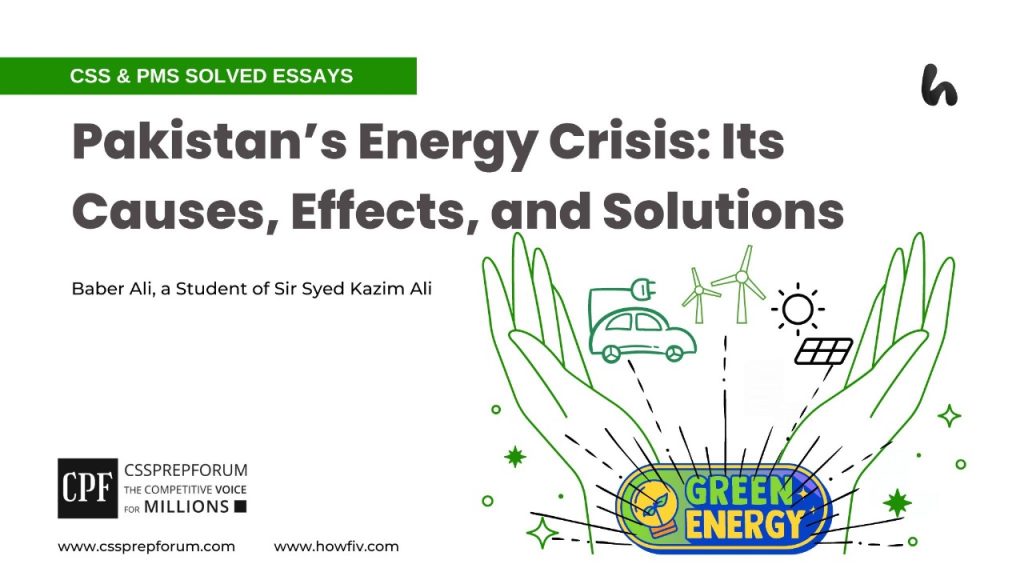Baber Ali, a Sir Syed Kazim Ali student, has attempted the CSS & PMS essay “Pakistan’s Energy Crisis: Its Causes, Effects, and Solutions” on the given pattern, which Sir Syed Kazim Ali teaches his students. Sir Syed Kazim Ali has been Pakistan’s top English writing and CSS, PMS essay, and precis coach with the highest success rate of his students. The essay is uploaded to help other competitive aspirants learn and practice essay writing techniques and patterns to qualify for the essay paper.

Outline
1- Introduction
2- The importance of energy for a country
3- Energy Crisis in Pakistan: A Critical Overview
- ✓Evidence: The National Electric Power Regulatory Authority (NEPRA) annual report states, “Pakistan is witnessing a shortfall of 7000 megawatts.”
4- What are the impacts of the energy crisis on Pakistan?
- ✓The increasing electricity load shedding countrywide
- Evidence: According to Lahore Electric Power Supply Company, the average load-shedding time is 5 hours a day.
- ✓ The textile industry is facing the worst time due to the power shortage
- Evidence: The Pakistan Board of Textiles Chairman stated, “Textile industry has never faced the worst time in history as it is facing today.”
- ✓Increasing the price of fertilizers, facilitating the country’s agriculture sector
- Evidence: According to the Pakistan Journal of Agricultural Sciences, the price of urea has increased up to 3 times within two years.
- ✓Shutting down of local industry, running upon electricity
- Evidence: According to the Survey of Pakistan, 80% of the local electricity industry is about to shut down.
- ✓Spending a considerable amount of 15 billion dollars on energy production
- Evidence: According to the State Bank of Pakistan’s annual report for 2022, “Pakistan paid 15 billion dollars for the payment of furnace oil.”
- ✓Experiencing the lowest count of Foreign Direct Investment FDI
- Evidence: According to the Division of Foreign Ministry, Pakistan has not fetched FDI projects for the last three years.
5-What are the causes behind the energy crisis in Pakistan?
- ✓The lack of political consensus
- Evidence: On 26 May 2008, the Federal Minister for Water and Power, Raja Pervez Ashraf, said, “Kalabagh Dam would not be constructed.”
- ✓The growing household appliance demand
- Evidence: According to the National Electric Power Regulatory Authority (NEPRA), the use of household appliances has increased by 400 per cent since 2015.
- ✓The Lack of dams in the country
- Case in point: According to the Food and Agriculture Organization, since its inception, Pakistan has built 150 dams, and India has built 5330 dams.
- ✓The expired infrastructure of the dams, resulting in less electricity production
- Evidence: According to the Water and Power Development Authority, Tarbela Dam and Mangla Dam have lost 50 per cent of their power-generating capacity.
- ✓The shortage of thermal power plants
- Evidence: According to the Pakistan Nuclear Regulatory Authority (NPRS), 41 thermal independent power producers with a total installed capacity of 18300 Megawatts are operational in Pakistan.
- ✓Non-shifting towards renewable energy resources
- Case in point: According to a report from the World Bank, China produces 430 million kilowatts from solar parks.
6-What has Pakistan done to tackle the energy crisis?
- ✓The National Power Policy, 2013
- ✓Power Generation Policy, 2015
- ✓ Alternative and Renewable Energy Policy, 2019
7-What practical measures can curb the crisis in Pakistan?
- ✓To build a robust political consensus over the energy crisis
- ✓To encourage the use of renewable energy resources
- ✓To limit the use of household appliances
- ✓To build more thermal power plants
- ✓To build more dams
- ✓ To repair the outdated infrastructure of the existing dams
- ✓To establish a theft-free power distribution system
8-Critical Analysis
9-Conclusion

As energy is a catalyst, boosting its social, political, and economic growth, the energy crisis is a significant roadblock in the development of any country. In fact, energy-insecure countries with dwindling economies always lag behind the rest of the countries socially and, above all, economically. It is saddening that Pakistan, being no exception, is counted among those states suffering from the energy crisis. Currently, the country is facing a shortfall of 7000 megawatts, a shutdown of the textile industry, increased fertilizer prices, and the lowest count of Foreign Direct Investments (FDI). Aiming towards the causes, the lack of political consensus, the growing household demand, and the absence of dams in the country are among the primary culprits. Moreover, the shortage of power generating plants and lack of shift towards renewable energy resources are fueling the fire. Nonetheless, the country has introduced the National Power Policy 2013, Power Generation Policy 2019, and Alternate and Renewable Energy Policy 2019. However, they still need to be facilitated to achieve the expected results. All hope is not lost, as even the darkest clouds have a silver lining. For the country, it is a must to build a robust political consensus over the crisis, encourage renewable energy sources, create more dams, and build more thermal powerhouses. This essay sheds light on the intensity of the menace of the energy crisis in Pakistan, its causes, impacts, and ways to counter the issue.
To begin with, energy has become a must to run the system of a state. Indeed, it is considered an indicator depicting the country’s progress socially and economically. It transforms the fate of the nation by empowering its economic stability. The countries that are self-sufficient in energy have a distinguished growth rate. For instance, Australia, self-sufficient in energy, has reached 1.53 trillion dollars in Gross Domestic Product GDP. The self-sufficiency in energy has made the country attain such miraculous progress. It is a glaring example depicting the importance of energy for a country’s economic well-being. Moreover, energy-self-sufficient states reap the financial benefits from international markets much more than energy-insecure countries by attracting foreign investors. Investors usually get attracted to states with sufficient power to meet the needs of their industrial sector. The economic stability in the energy crisis is a wild goose chase.
On the contrary, Pakistan is listed as an energy-insecure country. The country has not only failed to meet the domestic electricity needs but also failed to provide enough power to its industries. According to National Electric Power Regulatory Authority (NEPRA) reports, “Pakistan has a shortfall of 7000 megawatts of electricity.” Although 7000 megawatts seems to be a small figure, it is costing the country a loss of millions of dollars. Therefore, the vast supply and demand gap in power is an alarming sign for the government to pay dire attention to the issue. Such a vast shortfall is hampering the state’s progress socially and, above all, economically.
Moving towards the impacts, the country is facing an increasing load of shedding electricity, which has created many problems for the nation. It has barred the country’s socioeconomic progress by paralysing the local industry that runs on electricity. According to the British Broadcasting Centre (BBC), Pakistan’s load-shedding hours exceed 8 hours daily. The load-shedding of electricity has become a turmoil for people; ultimately, it has badly affected their social lives. In summer, the load-shedding proves to be fatal for the people living in metropolitan cities of the country as the houses in megacities, due to shortage of space, do not have proper ventilation mechanisms. According to another report by BBC, in 2015, “2000 deaths were recorded in Karachi due to heat-wave.” Nonetheless, the crisis is hampering the state’s economic stability and depriving the country of precious lives.
Next to it, the textile industry, considered oxygen for Pakistan’s dwindling economy, is facing a hard time due to the power shortage. As the government has failed to provide the required electricity to textile mills, most mill owners have shut down their factories due to frequent power cuts. According to the Pakistan Exports Bureau, in 2022, Pakistan has exported the least textile compared to the last ten years. Pakistan is ranked among the top exporter of textiles globally. As the Pakistan Textile Exporters Association mentioned, Pakistan exports textiles worth 16 billion dollars annually. The massive revenue that the country earns through such exports will shrink if the issue remains growing. Hence, the power cut to the mills can result in the oxygen cut to the gasping economy of the state.
Additionally, the agriculture sector, the backbone of the country’s economy, is not exempted from the impacts of the crisis. The fertilizer industries are frequently raising the prices of fertilizers, making electricity price hikes the reason. According to the Pakistan Journal of Agricultural Sciences 2022, the price of urea has increased up to 3 times within two years. Urea is an essential crop requirement and responsible for their rapid and healthy growth. As urea contains nitrogen, a fundamental need of plants, the farmers must use it in their crops. Without using urea, the crop yield can drop up to 20 per cent. However, the increased price of urea pushes it out of the buying power of a middle-class farmer. Hence, it would affect the crop yield; ultimately, the agriculture exports would shrink. As a result, the economy of the state would suffer.
In addition, the local industry, which depends on electricity, is struggling. It has affected many small industries, but the manufacturing factories, making candies and toys, mini flour mills, and grinding wheat and rice are struck by the crisis. As the Survey of Pakistan mentioned, 80% of the local industry’s electricity consumption is about to shut down. The majority of the people are associated with local industry. They earn their bread and butter by working in these small factories. The shutdown of the factories in such a large number would demand the government for employment while the country already lacks a job. However, those associated with the abovementioned businesses cannot run their mills. They are left with two options: shutting down the mills permanently or shifting their system to solar energy. Unfortunately, the taxes imposed by the government have made the solar panel prices sky-high. The government must address the issue before it worsens.
Similarly, the Foreign Direct Investment FDI drops to a surging level yearly. According to the Division of Foreign Ministry, Pakistan has not fetched FDI projects for the last three years. For a developing country, FDI is not just a mere cross-border investment, bringing precious revenue, but a matter of life and death for the country’s slacking economy. Besides the need for more investment by foreign investors, the existing ones are trying to close their business in the country. The lowering FDI indicates the shift of foreign investors towards other Asian countries with cheap labour and electricity. The continuous decline in the FDIs can rob millions of people of a bright future.
The country produces its energy from furnace oil; unluckily, it buys fuel from the international market. Consequently, a considerable amount of foreign reserves is utilized to pay this expenditure. According to the State Bank of Pakistan, “In 2022, Pakistan paid 15 billion dollars for furnace oil.” Power generation through furnace oil is the costliest method; however, developing countries have shifted towards renewable energy resources. Due to buying the oil on deferred payments, the oil sellers charge the country high prices. Currently, the country is facing economic declivity. Hence, the burden of expenses is like a bullet in its heart. The burden of payments deprives the government of such vast amounts of dollars annually.
As discussed, Impacts do not grow automatically. Nevertheless, many reasons exist behind this worst situation in the country. Here, it is essential to discuss some of the significant issues which have motivated the menace of the crisis in Pakistan. Moving towards the causes, several culprits are behind the prevalence of such menace. The lack of political consensus stands at the top of the line. Politicians want to avoid getting along on a single platform to deal with the crisis. For instance, the Kalabagh Dam is a matter of life and death for Pakistan, but some politicians have been using it as a weapon to achieve their vested political interests. On 26 May 2008, the Federal Minister for Water and Power, Raja Pervez Ashraf, said, “Kalabagh Dam would not be constructed.” Although constructing the Kalabagh dam is the need of the hour, the political parties belonging to Sindh and Khyber Pakhtunkhwa are playing the national card. The parties have manipulated the minds of innocent people by making them believe the Punjab would block the water of the Indus River after constructing the dam. With every passing day, the intensity of the crisis increases. Still, the politicians need to give the situation serious thought.
Further, the growing demand for household appliances is also a cause, fueling the fire. According to the National Electric Power Regulatory Authority NEPRA, “The use of household appliances has increased to 400 per cent since last 2015.” The excessive use of such appliances results in more electricity consumption, although the country is already experiencing a shortfall of 7000 megawatts. Moreover, the appliances that are used domestically are still manufactured based on old technology, and they need to be equipped with the latest features, such as energy efficiency. Nevertheless, being energy self-sufficient, Saudi Arabia uses a direct current (DC) voltage system cheaper than the alternate current (AC) voltage. Still, the AC voltage system propagates in Pakistan. Being energy inefficient, the appliances consume a massive amount of electricity. Being an energy-insecure country, Pakistan must pay attention to this loophole, contributing to the menace.
Next to it, Pakistan, an agriculture-driven country, has an unsatisfactory number of dams. Fifty per cent of the country’s electricity production comes from hydro-power, which depends on dams. According to the Food and Agriculture Organization, “Pakistan has built 150 dams since inception, and India has built 5330 dams.” Dams serve as power-generating bodies and also act as reservoirs for water storage. The electricity produced by dams is the cheapest as it is made through the flowing water of rivers, and Pakistan is blessed with enormous rivers, like the Indus, Ravi, and Jhelum Rivers. Therefore, the country has to work hard to construct several dams to meet its energy requirements.
Likewise, the existing dam infrastructure is expiring along with the shortage of dams, resulting in less electricity production. The dams have completed their life tenure, and the poor management of dams has made them malfunction. According to the Water and Power Development Authority WAPDA, “Tarbela Dam and Mangla Dam have lost their 50 per cent power generating capacity.” The dams have lost their maximum capacity to produce power and reserve water for non-maintenance, corruption in WAPDA, and non-appointment of qualified personnel. Due to the rampant corruption by WAPDA officials, the dams need to be provided with quality material; consequently, the life span of the dams is reduced. Hence, it is a potent factor contributing to the crisis surge.
Moreover, the country has a small number of thermal power plants, which is also a worse condition for the country. According to the Pakistan Nuclear Regulatory Authority NPRS, “In Pakistan, 41 thermal independent power producers with a total installed capacity of 18300 Megawatts are operational.” Thermal power plants are the most common source of energy production. As heat energy is converted into electricity in thermal stations, Pakistan, having immense reserves of coal, can use them to generate electricity. According to the Sindh Coal Authority report, Sindh’s total coal reserves are estimated to be 184 billion tons. Adding to it, the Thar-Coalfield, situated in district Tharparkar, is ranked as the 16th largest coal reserve field in the world. The establishment of new thermal power plants and utilization of this coal in the powerhouses would not only make the country energy self-sufficient but also make it possible to export the power to neighbouring countries.
Besides, the country has not shifted itself to renewable energy resources. Renewable energy is derived from natural sources, replenishing at a higher rate than consumed. Due to its geo-strategic position, Pakistan has abundant renewable energy sources, like solar energy, wind energy, and ocean tides. For instance, according to a report from the World Bank, China produces 430 million kilowatts from solar parks. Despite having sufficient renewable energy sources, Pakistan still needs to make the most of it. Although the country has an average of 12 hours of daylight throbbing winds at the coastal line of Thatta, Badin, and Jhampir, it can install solar parks and wind turbines in such regions, reducing the burden from thermal power stations.
All hope is not lost, as every tunnel has light at its end. The country can overcome the issue by implementing the following recommendations. First of all, building a robust political consensus among policymakers over the issue of the energy crisis is the need of the hour. It is the first step towards getting rid of the situation. However, the political parties playing the national card over the issue of Kalabagh Dam must be trialled in a court of law as they are proving to be a hurdle in the integrity of the state. Next to it, encouraging the use of renewable energy resources can address the crisis. Equipped with enormous renewable energy resources, Pakistan should install solar parks in the desert region and wind turbines in the coastal lines. The one-time capital investment in renewable energy machinery would give the country lifetime benefits. Additionally, the price of solar panels must be decreased to make them purchasable for an ordinary man. As ordinary people could meet their energy requirements by purchasing solar panels from the market, this initiative would lessen the burden of providing power to every house in the state.
Further, the country desperately needs dams, and building more dams would be a lifeline for the country’s energy sector. As the country generates its electricity by water, more dams can get it out of the crisis. It has become a must for the government to revolutionize its hydel system. Furthermore, the infrastructure of the existing dams needs to be adequately repaired and maintained. Due to the accumulation of sand at the bottom of the dams, their maximum capacity is hindered. A proper check and balance mechanism to clean the dams must be propagated daily.
Moreover, the government should make policies to limit the use of household appliances as little as one can. The government should also import and manufacture household appliances that consume less electricity. For instance, 12-watt energy appliances consume less electricity; therefore, such appliances should be encouraged. Additionally, the government should invest in thermal power plants. Thermal energy can be easily obtained from fossils, which the country has in abundance in the form of coal. The country should construct thermal powerhouses as much as it can.
Last, a proper power distribution mechanism must be introduced nationwide. A considerable amount of electricity is wasted as line losses. Moreover, the government fails to collect the appropriate revenue due to illegal electricity connections. Thus, a sovereign and accountable system is a must in countering the menace.
Critically, Pakistan has a shortage of energy. The issue has been present since the beginning, but it has remained unnoticed. However, with every passing year, it keeps growing. The non-cooperative and indifferent attitude or the political elite and the failure to shift towards renewable energy resources has fueled the fire.
In a nutshell, Pakistan is impacted by the energy crisis due to several causes, such as lack of political consensus, shortage of dams, and lack of attention towards renewable energy sources. However, some recommendations can make the country self-sufficient in power, like creating new dams, building political consensus, shifting to renewable energy sources, and establishing a robust power distribution system free from theft and corruption.

CSS Solved Past Papers’ Essays
Looking for the last ten years of CSS and PMS Solved Essays and want to know how Sir Kazim’s students write and score the highest marks in the essays’ papers? Then, click on the CSS Solved Essays to start reading them.
CSS Solved Essays
CSS Solved General Science & Ability Past Papers
Want to read the last ten years’ General Science & Ability Solved Past Papers to learn how to attempt them and to score high? Let’s click on the link below to read them all freely. All past papers have been solved by Miss Iqra Ali & Dr Nishat Baloch, Pakistan’s top CSS GSA coach having the highest score of their students. General Science & Ability Solved Past Papers
Articles Might Interest You!
The following are some of the most important articles for CSS and PMS aspirants. Click on any to start reading.












